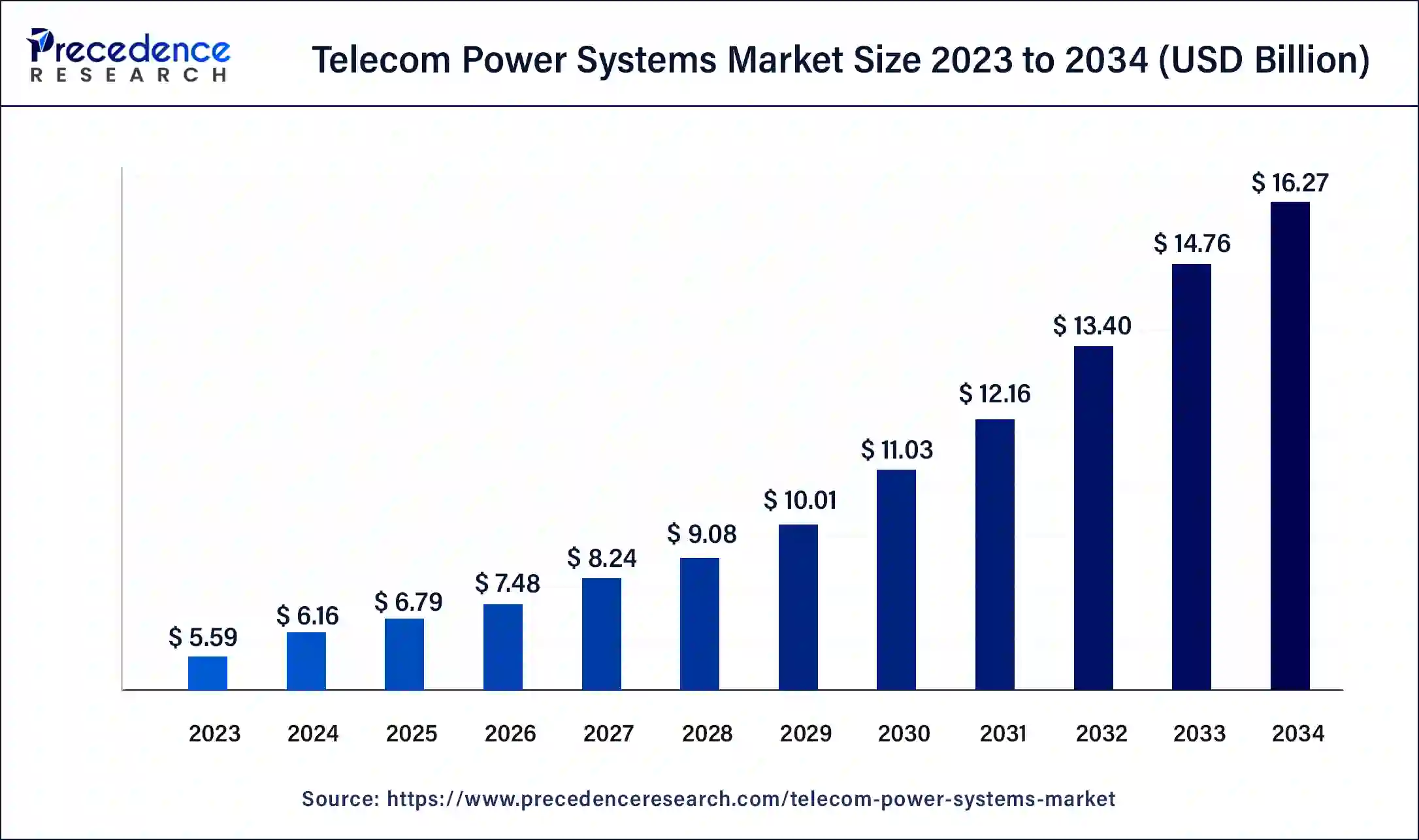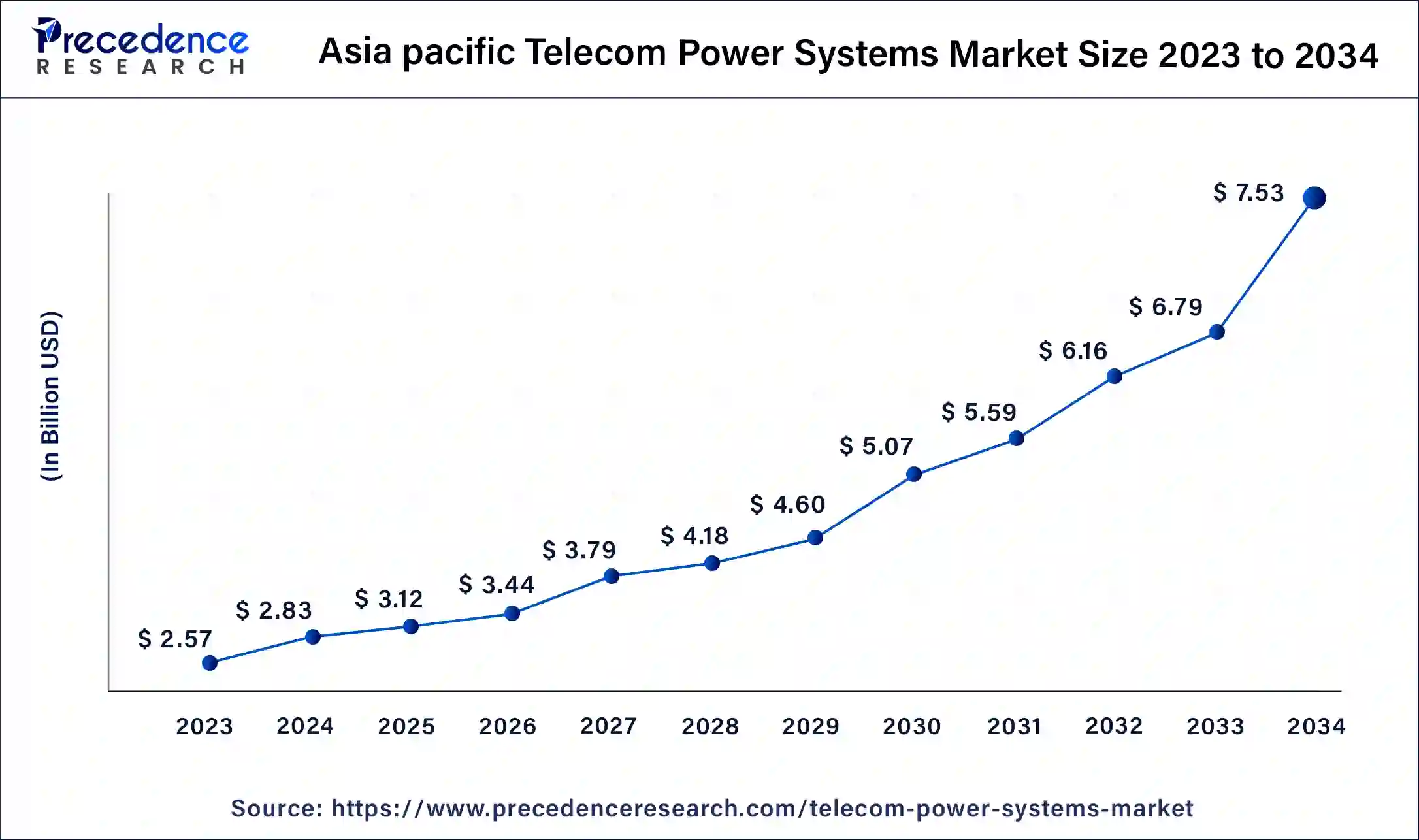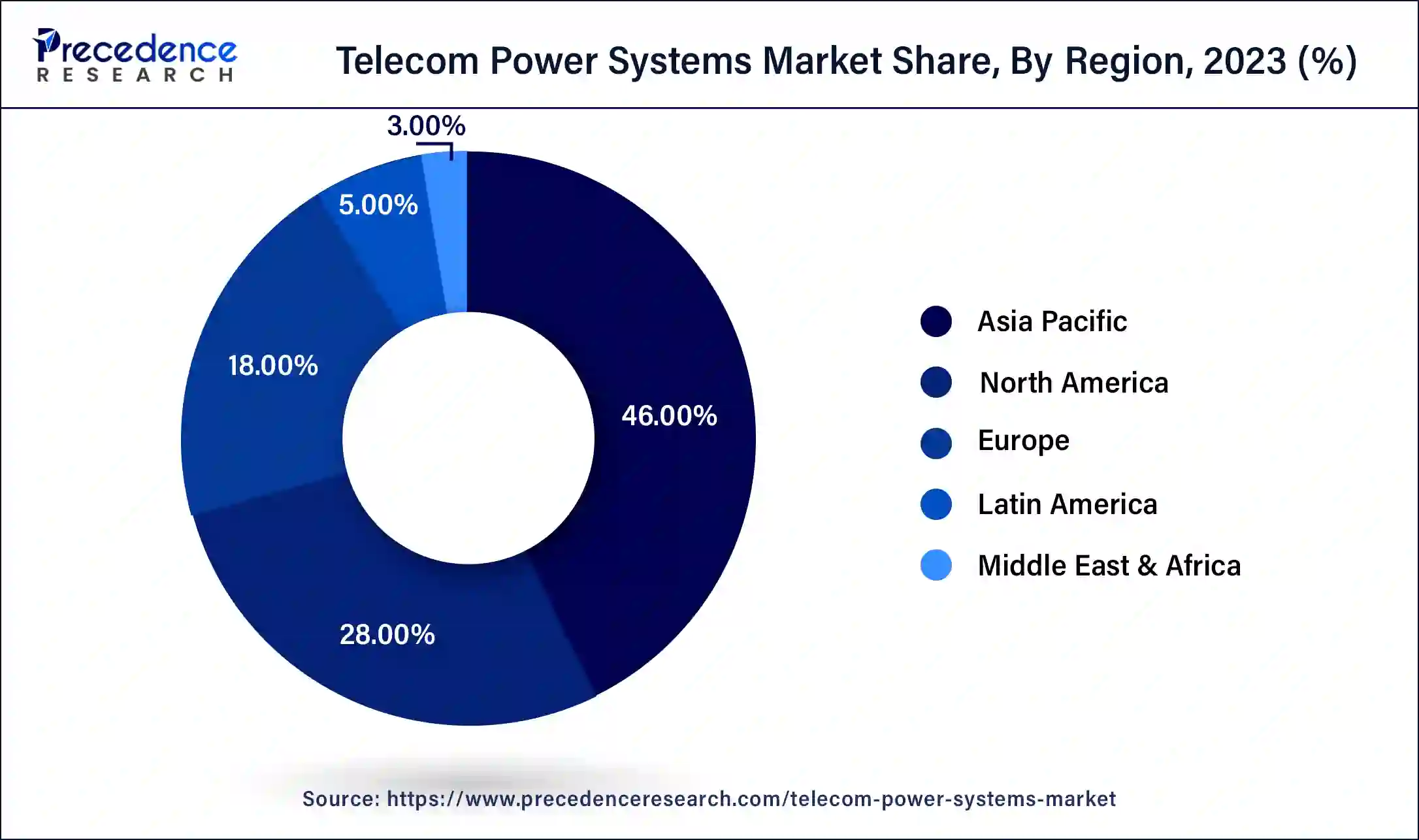What is Telecom Power Systems Market Size?
The global telecom power systems market size is estimated at USD 6.79 billion in 2025 and is anticipated to reach around USD 16.27 billion by 2034, representing a healthy CAGR of 10.20% between 2025 and 2034.

Market Highlights
- Asia Pacific contributed more than 46% of revenue share in 2024.
- Europe is estimated to expand the fastest CAGR between 2025 and 2034.
- By product, the DC power systems segment has held the largest market share of 62% in 2024.
- By product, the digital electricity segment is anticipated to grow at a remarkable CAGR of 14.5% between 2025 and 2034.
- By grid type, the on-grid segment generated over 42% of revenue share in 2024.
- By grid type, the off-grid segment is expected to expand at the fastest CAGR over the projected period.
- By power source, the diesel-battery segment had the largest market share of 47% in 2024.
- By power source, the diesel-solar segment is expected to expand at the fastest CAGR over the projected period.
- By power rating, the 10-20 KW segment generated over 54% of revenue share in 2024.
- By power rating, the above 20 KW segment is expected to expand at the fastest CAGR over the projected period.
Market Overview
The telecom power systems market encompasses the global industry dedicated to providing reliable and efficient power solutions for telecommunication networks. These systems ensure uninterrupted power supply for critical telecom infrastructure, such as base stations, data centers, and communication hubs. The market is driven by the increasing demand for seamless communication services and the deployment of 5G networks. Key components include backup power systems, energy storage solutions, and power distribution units. Telecom power systems are crucial for maintaining network stability, minimizing downtime, and supporting the expanding infrastructure of telecommunications in our digitally connected world.
Growth Factors
- Growing demand for seamless communication services and the rapid expansion of 5G networks drive the market.
- Telecom power systems are essential for supporting the expanding infrastructure of global telecommunication networks.
- Increasing focus on energy-efficient power systems to reduce operational costs and environmental impact.
- Integration of renewable energy sources for sustainable and eco-friendly power solutions.
- The rising adoption of edge computing in telecom infrastructure, leading to localized power requirements.
- Evolving power system requirements to support the increasing deployment of 5G infrastructure.
- Adoption of smart grid technologies to enhance the efficiency and reliability of telecom power systems.
- Development and deployment of advanced battery technologies for efficient energy storage.
- Providing remote monitoring solutions to enhance the management and maintenance of telecom power systems.
- Offering hybrid power solutions that integrate traditional and renewable sources for optimal energy efficiency.
- As edge computing gains prominence, opportunities arise for powering distributed telecom infrastructure at the network's edge.
- Providing energy storage solutions as a service, offering flexibility and cost-effectiveness for telecom operators.
- The ongoing digital transformation in telecommunication fuels the need for robust and advanced power solutions.
Telecom Power Systems MarketTrends
- Hybrid energy systems are becoming mainstream, as telecom companies combine solar, wind, batteries, and backup generators to reduce fuel usage, lower operating costs, and improve power stability for tower sites.
- Advanced battery technologies are replacing older systems, with lithium-ion batteries gaining strong preference due to their longer life, higher efficiency, and ability to support faster charging cycles in high-demand telecom environments.
- Modular and prefabricated power units are increasingly used, helping companies speed up tower deployment, reduce installation complexities, and improve flexibility for scaling power capacity as network demand grows.
- Green and renewable power solutions are becoming essential, with telecom providers focusing on solar-powered and low-emission systems to meet sustainability targets and reduce dependency on diesel generators.
- Rising network reliability requirements are reshaping system design, especially with the rollout of 5G, which demands more stable, high-capacity, and uninterrupted power backup solutions.
- Operators are facing growing pressure to cut energy costs, leading to greater investment in energy-efficient equipment and remote monitoring, to enhance production efficiency and improve xylene purity.
Market Outlook
- Industry Growth Overview: The market for telecom power systems is growing as a result of the expanding deployment of 4G and 5G networks and the growing demand for continuous power supply in telecom infrastructure. Growth is also being driven by expanding broadband, growing mobile connectivity, and the need for energy-efficient power solutions. Adoption of hybrid solutions. Adoption of hybrid solutions and backup power is also increasing.
- Sustainability Trends:Reducing reliance on diesel generators, integrating renewable energy, and energy-efficient power systems are the main priorities. Lithium-ion battery systems and solar-powered telecom towers are increasingly being used to lower operating costs and carbon footprints.
- Startup Economy: Startups are developing advanced energy storage systems, smart UPS solutions, and hybrid renewable power integration for telecom towers. They also focus on IoT-enabled monitoring and predictive maintenance for improved reliability.
Market Scope
| Report Coverage | Details |
| Market Size in 2025 | USD 6.79 Billion |
| Market Size in 2026 | USD 7.48 Billion |
| Market Size by 2034 | USD 16.27 Billion |
| Growth Rate from 2025 to 2034 | CAGR of 10.20% |
| Largest Market | Asia Pacific |
| Base Year | 2024 |
| Forecast Period | 2025 to 2034 |
| Segments Covered | Product, Grid Type, Power Source, Power Rating, and Region |
| Regions Covered | North America, Europe, Asia-Pacific, Latin America, and Middle East & Africa |
Market Dynamics
Drivers
5G network expansion and smart grid technologies
The surge in 5G network expansion is a primary driver propelling the demand for T telecom power systems. The deployment of 5G brings unprecedented data speeds and connectivity, requiring robust and efficient power solutions. telecom power systems are crucial to supporting the increased infrastructure demands, ensuring reliable and uninterrupted power supply for the vast number of base stations and data centers integral to 5G networks. As the global adoption of 5G accelerates, the demand for advanced telecom power systems rises, driving innovation in energy-efficient and scalable solutions to meet the evolving needs of high-speed and low-latency communication.
The integration of smart grid technologies significantly contributes to the market demand for telecom power systems. Smart grids enhance the efficiency, reliability, and adaptability of power distribution in telecommunication networks.
By incorporating intelligent monitoring, control, and optimization features, smart grid technologies enable telecom power systems to operate seamlessly, responding dynamically to demand fluctuations. This integration not only enhances energy efficiency but also aligns with the broader trend of sustainable and resilient telecom infrastructure, positioning telecom power systems as vital components in the evolving landscape of smart and interconnected communication networks.
Restraint
Interoperability challenges and limited access to remote areas
Interoperability challenges pose a significant restraint on the demand for telecom power systems. The diverse range of equipment and technologies used in telecommunication networks often lacks standardized interfaces, hindering seamless integration of power systems. This complexity complicates the management and coordination of diverse components, potentially leading to inefficiencies and compatibility issues. Overcoming interoperability challenges is crucial for ensuring a cohesive and integrated telecom power infrastructure that can adapt to the evolving needs of the industry.
Limited access to remote areas presents a notable constraint on the market demand for telecom power systems. Many remote and underserved regions lack adequate infrastructure, making it challenging to deploy and maintain power systems for telecom networks. The absence of reliable power sources in these areas hampers network expansion, hindering connectivity and communication services. Addressing these accessibility issues is vital for unlocking the full potential of the telecom power systems market and ensuring comprehensive coverage and connectivity, especially in remote and underserved regions.
Opportunity
Rural electrification initiatives and advanced battery technologies
Rural electrification initiatives play a pivotal role in surging demand for the telecom power systems market by extending connectivity to remote areas. As governments and organizations strive to bridge the digital divide, the need for robust telecom infrastructure in rural locations rises. Telecom power systems have become essential for providing reliable energy solutions to support communication networks in these off-grid and underserved regions. The deployment of power-efficient solutions in tandem with rural electrification projects facilitates enhanced connectivity, empowering communities and promoting economic development.
The integration of advanced battery technologies significantly contributes to the growing demand for telecom power systems. As energy storage becomes a critical component in ensuring uninterrupted power supply, advanced batteries enhance the efficiency and reliability of these systems. Lithium-ion and other innovative battery technologies offer improved energy density, longer lifespan, and faster charging capabilities, addressing the evolving needs of telecom networks. This surge in advanced battery adoption aligns with the industry's pursuit of sustainable and resilient solutions, further propelling the demand for telecom power systems in the market.
Segment Insights
Product Insights
The DC power segment has held a 62% revenue share in 2024. DC power in telecom power systems refers to the use of direct current for providing electrical power to telecommunication equipment. It involves converting alternating current (AC) to DC, minimizing energy loss and enhancing efficiency. This approach is integral in telecom infrastructure, offering a reliable and stable power supply for various applications, including base stations and data centers.
The digital electricity segment is anticipated to expand at a significant CAGR of 14.5% during the projected period. Digital electricity in telecom power systems refers to the incorporation of digital technologies for efficient power management. It involves smart grid technologies, IoT integration, and digital monitoring to optimize energy consumption and enhance overall system performance. This trend reflects the industry's shift towards intelligent and data-driven solutions, contributing to improved reliability and sustainability in telecom power systems.
Grid Type Insights
The on-grid segment held the largest market share of 42% in 2024. On-grid telecom power systems are integrated with the main electrical grid, drawing power directly from the utility. This grid connectivity ensures a consistent and reliable energy supply for telecom infrastructure. The trend in on-grid solutions involves optimizing energy efficiency and exploring renewable energy integration to reduce dependence on traditional power sources, aligning with sustainability goals.
On the other hand, the off-grid segment is projected to grow at the fastest rate over the projected period. Off-grid telecom power systems operate independently of the main electrical grid, crucial for remote or underserved areas. Trends in off-grid solutions include advancements in energy storage technologies, leveraging advanced batteries and renewable sources like solar or wind, enhancing reliability and reducing environmental impact in off-grid telecom deployments.
Power Source Insights
The diesel-battery power segment had the highest market share of 47% in 2022. In telecom power systems, a diesel-battery power source combines traditional diesel generators with advanced battery technology. This hybrid system ensures continuous power supply, utilizing diesel generators for primary energy and integrating batteries for energy storage and load optimization. This approach reduces fuel consumption, minimizes environmental impact, and enhances overall system efficiency.
The diesel-solar power segment is anticipated to expand at the fastest rate over the projected period. A diesel-solar power source in telecom power systems integrates diesel generators with solar panels. This hybrid solution harnesses solar energy to supplement diesel power, reducing reliance on conventional fuel, cutting operational costs, and aligning with sustainable energy practices, making it a trend in the pursuit of eco-friendly and cost-effective telecom power solutions.
Power Rating Insights
The 10-20 KW segment had the highest market share of 54% in 2022. Telecom power systems in the 10-20 KW range cater to smaller-scale installations, providing efficient and reliable power for medium-sized telecommunication infrastructure. These systems offer a balanced solution for sites with moderate power requirements, ensuring optimal performance and energy management.
The above 20 KW segment is anticipated to expand at the fastest rate over the projected period. Telecom power systems above 20 KW are designed for larger-scale deployments, addressing the increasing power demands of extensive telecommunication networks. These high-capacity systems incorporate advanced technologies to support the expanding infrastructure, promoting sustainability, and addressing the challenges of larger-scale energy requirements in the telecom industry.
Regional Insights
Asia Pacific Telecom Power Systems Market Size and Growth 2025 To 2034
The Asia Pacific telecom power systems market size is valued at USD 3.12 billion in 2025 and is expected to surpass around USD 7.53 billion by 2034, growing at a CAGR of 10.27% from 2025 to 2034.

Asia Pacific has held the largest revenue share of 46% in 2024. In Asia Pacific, the telecom power systems market is witnessing robust growth driven by the rapid expansion of telecommunication infrastructure. Countries like China and India are investing significantly in 5G deployment and rural connectivity, fueling the demand for reliable power solutions. The region's focus on digital transformation and smart city initiatives further accentuates the need for advanced and scalable telecom power systems to support evolving networks.

Europe is estimated to observe the fastest expansion. Europe's telecom power systems market reflects a trend towards sustainable and energy-efficient solutions. With an emphasis on renewable energy integration and stringent environmental regulations, European countries are adopting advanced battery technologies and smart grid solutions. The region's commitment to reducing carbon footprints aligns with the growing demand for resilient and eco-friendly power systems in the telecommunications sector.
In North America, the telecom power systems market is characterized by a strong emphasis on innovation and reliability. The region adopts cutting-edge technologies, including advanced battery storage and smart grid solutions, to ensure seamless and sustainable telecom operations. With a focus on 5G deployment and smart city initiatives, North America showcases a dynamic landscape where telecom power systems play a crucial role in supporting the evolving needs of modern communication networks.
Telecom Power Systems Market Companies
- Schneider Electric SE
- Huawei Technologies Co., Ltd.
- Delta Electronics, Inc.
- Eaton Corporation
- Vertiv Co.
- Emerson Electric Co.
- Cummins Inc.
- GE Power (General Electric)
- Ascot Industrial S.r.l.
- Mitsubishi Electric Corporation
- PowerOasis Ltd.
- Tycon Systems Inc.
- Eltek AS (Delta Group)
- GS Yuasa Corporation
- C&D Technologies, Inc.
Recent Developments
- In March 2025, ITU & Huawei jointly released a white paper on lithium batteries for telecom sites. The paper highlights safety standards, efficiency, and global best practices for deploying lithium-ion batteries in mobile network infrastructure. (Source: https://www.prnewswire.com)
- In April 2025, Pearce acquired JoeMax Telecom LLC to expand engineering and power systems capabilities. This acquisition strengthens Pearce's mission-critical power infrastructure presence in telecom, adding site acquisition and project management expertise. (Source: https://www.htfmarketintelligence.com)
- In March 2025, China Mobile announced procurement of 1.95 GWh lithium-iron-phosphate (LiFePO₄) batteries for telecom base stations. This major order reflects the telecom operator's shift from lead-acid to more durable and efficient lithium‑ion backup solutions. (Source: https://news.metal.com)
- In 2022, ABB Ltd has forged a strategic alliance with Direct Energy Partners (DEP), a startup dedicated to advancing Direct Current (DC) microgrids for energy transformation. ABB's venture capital unit, ABB Technology Ventures, will make an undisclosed minority investment as part of this partnership, contributing to the acceleration of DC microgrid adoption.
- In 2022, Huawei has unveiled PowerPOD 3.0, a cutting-edge power supply solution leveraging a converged architecture and the ultra-high-density UPS5000-H. This innovation enhances power density per cabinet, optimizing the space layout of the power supply system and introducing advancements in efficient and compact power delivery.
- In 2022, Ericsson successfully trialed Deutsche Telekom's 5G-enabled network, marking a significant stride in sustainable mobile site operations. The trial's success suggests potential advancements in leveraging renewable energy, enhancing efficiency, and achieving a balanced supply-demand equilibrium in the realm of 5G networks.
Segments Covered in the Report
By Product
- AC Power Systems
- DC Power Systems
- Digital Electricity
- Others
By Grid Type
- On-Grid
- Off-Grid
- Bad Grid
By Power Source
- Diesel-Battery
- Diesel-Solar
- Diesel-Wind
- Others
By Power Rating
- Below 10 KW
- 10-20 KW
- Above 20 KW
By Region
- North America
- Europe
- Asia-Pacific
- Latin America
- Middle East and Africa
For inquiries regarding discounts, bulk purchases, or customization requests, please contact us at sales@precedenceresearch.com
Frequently Asked Questions
Ask For Sample
No cookie-cutter, only authentic analysis – take the 1st step to become a Precedence Research client




 sales@precedenceresearch.com
sales@precedenceresearch.com
 +1 804-441-9344
+1 804-441-9344